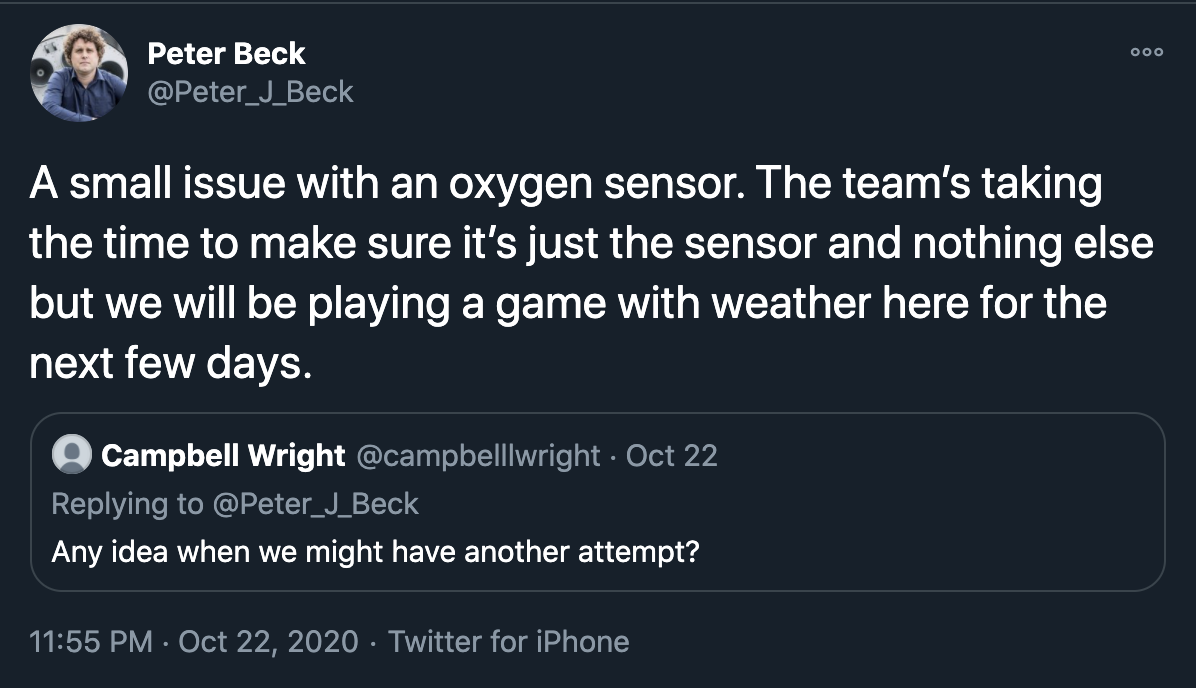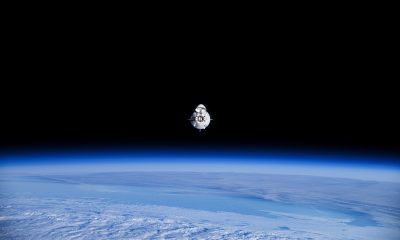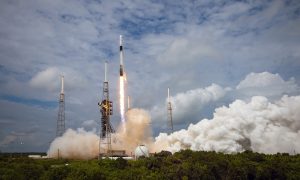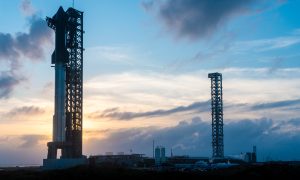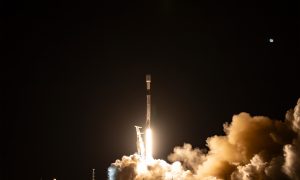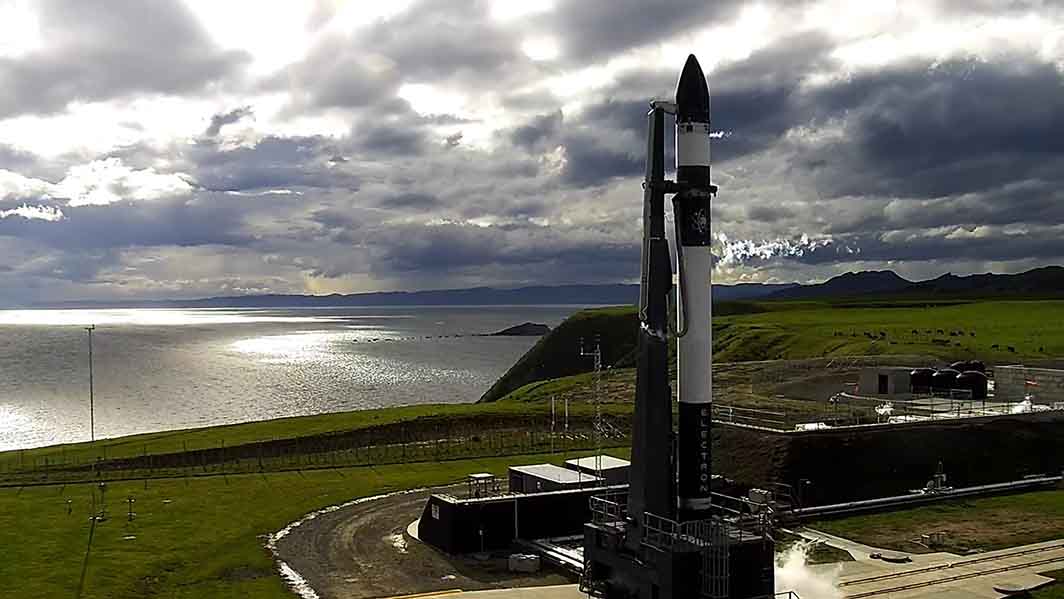

News
Rocket Lab “In Focus” mission ready to launch after scrubbed first attempt
On Wednesday, October 21, Rocket Lab held a launch countdown ahead of the fifteenth mission of its small rocket, Electron. The mission nicknamed “In Focus,” was slated to take off from the company’s primary launch pad at Launch Complex 1 on the Mahia Peninsula in New Zealand. Ultimately, the launch attempt was scrubbed due to an off-nominal oxygen sensor.
Rocket Lab did not immediately disclose a new targeted launch date, but did state that the launch window for the “In Focus” mission extended for nearly two-weeks. Rocket Lab founder and chief executive officer, Peter Beck, said in a Twitter post that, “the team’s taking the time to make sure it’s just the sensor and nothing else.” Beck also stated that weather moving into the area could pose a challenge for finding a new acceptable launch date.
Just two days later, Rocket Lab announced that a second launch attempt of the rideshare mission supporting ten Earth-observation satellites would occur at 5:14pm EDT (21:14 UTC) Wednesday, October 28. Should the second attempt be thwarted by uncooperative weather, daily opportunities to launch Electron are available until November 3.
What’s on board:
The fifteenth overall flight of Electron and fifth mission of 2020, is a rideshare mission that supports payloads for Canon Electronics Inc. and Earth-imaging services provider Planet. The payload, carefully mounted on the Rocket Lab Electron Kick Stage, consists of one nine SuperDove Flock 4e Planet microsatellites inside of Rocket Lab’s protective Maxwell payload dispensers. The entire stack is topped by Canon Electronics Inc.’s CE-SAT-IIB satellite procured by mission management provider Spaceflight Inc. All ten payloads are securely fixed atop the Electron Kick Stage.
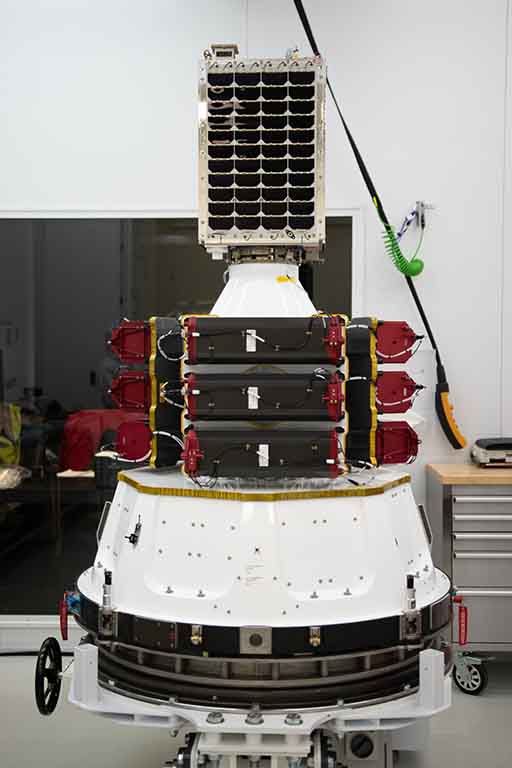
The Electron Kick Stage – a capable extra stage on Electron – is designed to circularize orbits and deploy multiple payloads to independent and precise destinations. The Kick Stage is powered by a small, but powerful Curie engine. All ten of the satellite payloads aboard the “In Focus” mission are expected to be delivered to a 500km morning-crossing Sun Synchronous Orbit.
Prior to flight, the payload was encapsulated inside of the Electron’s protective payload fairing. In traditional fashion, Rocket Lab outfitted the fairing with the mission patch artwork created specifically for Electron’s fifteenth “In Focus” mission.
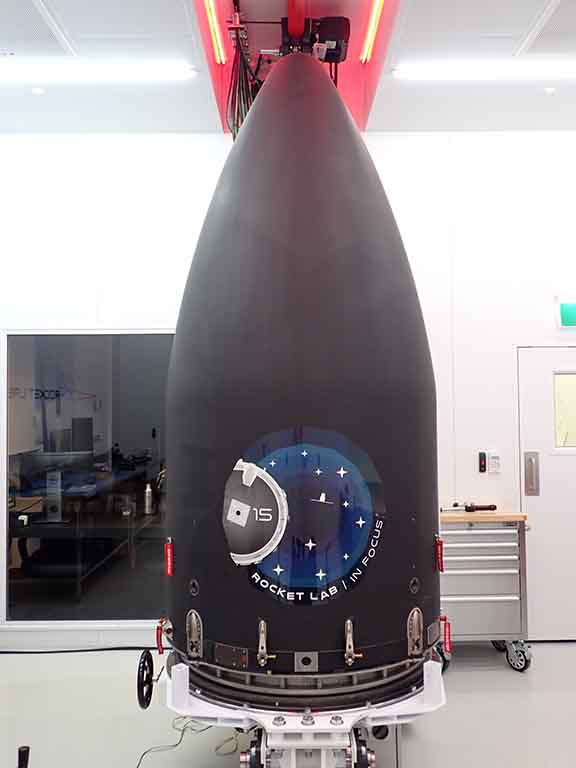
After encapsulation inside the fairing, the payload was integrated with the Electron first-stage booster. After a short trip from the assembly facility, Electron was raised vertically at Launch Complex 1 to complete a successful wet dress rehearsal – a standard pre-flight run-through of all launch procedures. The purpose of the wet dress rehearsal is to run through all of the launch day procedures including filling the rocket with RP-1 – a rocket grade kerosene – and liquid oxygen.
Launch teams conducted the practice launch on Thursday, October 8 proceeding through all countdown milestones right up until T-0 and engine ignition. This process ensures that the vehicle and launch teams are ready for flight. It also provides an opportunity to catch and address any anomalies that may arise prior to launch day.
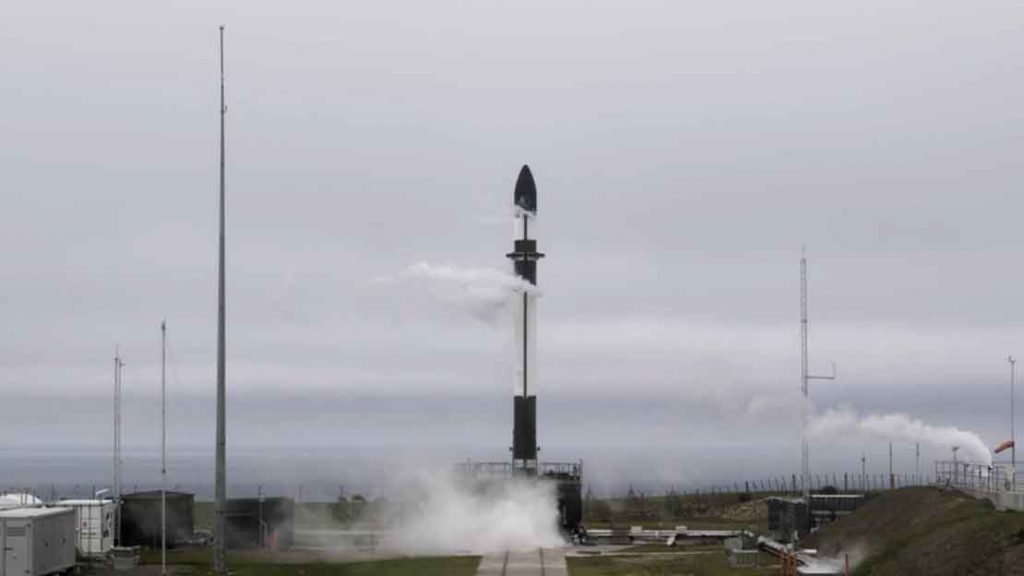
What to expect on launch day:
Approximately four hours ahead of the launch attempt Rocket Lab will once again return Electron to vertical launching position at Launch Complex 1 in New Zealand. In the time prior to the fueling of the rocket, safety checks of the launch complex will be conducted and marine hazard zones and airspace will be closed and secured to all traffic. Fueling of the rocket will begin just two hours ahead of the launch attempt.
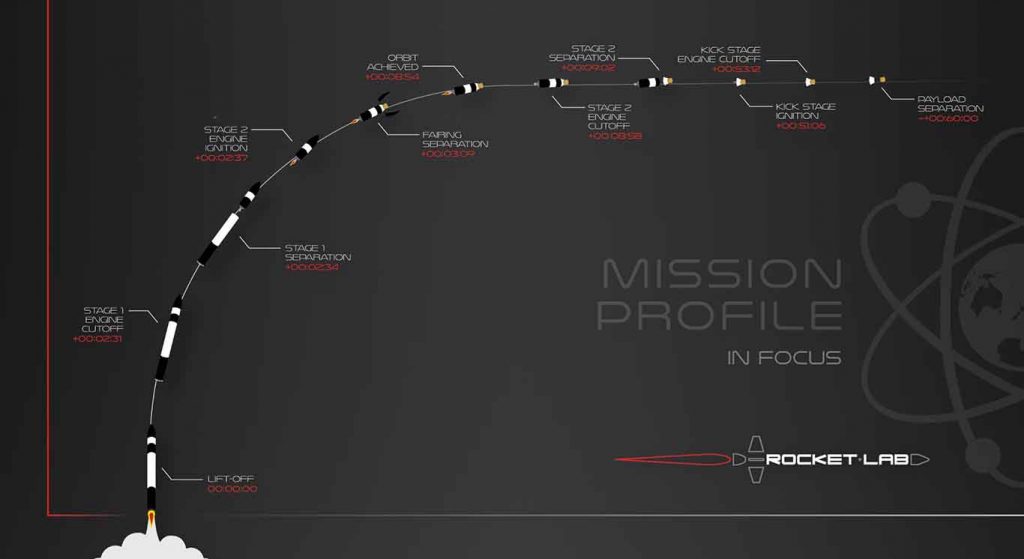
At T-0 Electron will be propelled to space by nine 3D-printed Rutherford electro-turbopump engines. Approximately 2 minutes and 34 seconds after liftoff Electron’s first stage will separate while the second stage engine ignites. Unique to the Electron, a “hot swap” of the batteries powering the electro-turbopump of the second stage will be performed – swapping out the power source of expelled batteries with new ones – at 6 minutes and 32 seconds after liftoff. The second stage is expected to arrive at an initial parking orbit approximately 8 minutes and 54 seconds after liftoff.
A brief ten seconds later the Kick Stage will separate from the second stage. Approximately 51 minutes and 06 seconds after liftoff the Kick Stage’s Curie engine will ignite to propel the payloads to their final circular Sun-Synchronous Orbits. Payload deployment is expected at the 60-minute mark after liftoff.
Rocket Lab will provide a live hosted webcast of the second launch attempt of the “In Focus” mission on Wednesday, October 28 on the company’s YouTube channel approximately fifteen minutes before liftoff. Should a scrub occur, Rocket Lab will announce a new targeted launch date on the company’s social media channels.
Elon Musk
Why Tesla’s Q3 could be one of its biggest quarters in history
Tesla could stand to benefit from the removal of the $7,500 EV tax credit at the end of Q3.

Tesla has gotten off to a slow start in 2025, as the first half of the year has not been one to remember from a delivery perspective.
However, Q3 could end up being one of the best the company has had in history, with the United States potentially being a major contributor to what might reverse a slow start to the year.
Earlier today, the United States’ House of Representatives officially passed President Trump’s “Big Beautiful Bill,” after it made its way through the Senate earlier this week. The bill will head to President Trump, as he looks to sign it before his July 4 deadline.
The Bill will effectively bring closure to the $7,500 EV tax credit, which will end on September 30, 2025. This means, over the next three months in the United States, those who are looking to buy an EV will have their last chance to take advantage of the credit. EVs will then be, for most people, $7,500 more expensive, in essence.
The tax credit is available to any single filer who makes under $150,000 per year, $225,000 a year to a head of household, and $300,000 to couples filing jointly.
Ending the tax credit was expected with the Trump administration, as his policies have leaned significantly toward reliance on fossil fuels, ending what he calls an “EV mandate.” He has used this phrase several times in disagreements with Tesla CEO Elon Musk.
Nevertheless, those who have been on the fence about buying a Tesla, or any EV, for that matter, will have some decisions to make in the next three months. While all companies will stand to benefit from this time crunch, Tesla could be the true winner because of its sheer volume.
If things are done correctly, meaning if Tesla can also offer incentives like 0% APR, special pricing on leasing or financing, or other advantages (like free Red, White, and Blue for a short period of time in celebration of Independence Day), it could see some real volume in sales this quarter.
You can now buy a Tesla in Red, White, and Blue for free until July 14 https://t.co/iAwhaRFOH0
— TESLARATI (@Teslarati) July 3, 2025
Tesla is just a shade under 721,000 deliveries for the year, so it’s on pace for roughly 1.4 million for 2025. This would be a decrease from the 1.8 million cars it delivered in each of the last two years. Traditionally, the second half of the year has produced Tesla’s strongest quarters. Its top three quarters in terms of deliveries are Q4 2024 with 495,570 vehicles, Q4 2023 with 484,507 vehicles, and Q3 2024 with 462,890 vehicles.
Elon Musk
Tesla Full Self-Driving testing continues European expansion: here’s where
Tesla has launched Full Self-Driving testing in a fifth European country ahead of its launch.

Tesla Full Self-Driving is being tested in several countries across Europe as the company prepares to launch its driver assistance suite on the continent.
The company is still working through the regulatory hurdles with the European Union. They are plentiful and difficult to navigate, but Tesla is still making progress as its testing of FSD continues to expand.
Today, it officially began testing in a new country, as more regions open their doors to Tesla. Many owners and potential customers in Europe are awaiting its launch.
On Thursday, Tesla officially confirmed that Full Self-Driving testing is underway in Spain, as the company shared an extensive video of a trip through the streets of Madrid:
Como pez en el agua …
FSD Supervised testing in Madrid, Spain
Pending regulatory approval pic.twitter.com/txTgoWseuA
— Tesla Europe & Middle East (@teslaeurope) July 3, 2025
The launch of Full Self-Driving testing in Spain marks the fifth country in which Tesla has started assessing the suite’s performance in the European market.
Across the past several months, Tesla has been expanding the scope of countries where Full Self-Driving is being tested. It has already made it to Italy, France, the Netherlands, and Germany previously.
Tesla has already filed applications to have Full Self-Driving (Supervised) launched across the European Union, but CEO Elon Musk has indicated that this particular step has been the delay in the official launch of the suite thus far.
In mid-June, Musk revealed the frustrations Tesla has felt during its efforts to launch its Full Self-Driving (Supervised) suite in Europe, stating that the holdup can be attributed to authorities in various countries, as well as the EU as a whole:
Tesla Full Self-Driving’s European launch frustrations revealed by Elon Musk
“Waiting for Dutch authorities and then the EU to approve. Very frustrating and hurts the safety of people in Europe, as driving with advanced Autopilot on results in four times fewer injuries! Please ask your governing authorities to accelerate making Tesla safer in Europe.”
Waiting for Dutch authorities and then the EU to approve.
Very frustrating and hurts the safety of people in Europe, as driving with advanced Autopilot on results in four times fewer injuries!
Please ask your governing authorities to accelerate making Tesla safer in Europe. https://t.co/QIYCXhhaQp
— Elon Musk (@elonmusk) June 11, 2025
Tesla said last year that it planned to launch Full Self-Driving in Europe in 2025.
Elon Musk
xAI’s Memphis data center receives air permit despite community criticism
xAI welcomed the development in a post on its official xAI Memphis account on X.

Elon Musk’s artificial intelligence startup xAI has secured an air permit from Memphis health officials for its data center project, despite critics’ opposition and pending legal action. The Shelby County Health Department approved the permit this week, allowing xAI to operate 15 mobile gas turbines at its facility.
Air permit granted
The air permit comes after months of protests from Memphis residents and environmental justice advocates, who alleged that xAI violated the Clean Air Act by operating gas turbines without prior approval, as per a report from WIRED.
The Southern Environmental Law Center (SELC) and the NAACP has claimed that xAI installed dozens of gas turbines at its new data campus without acquiring the mandatory Prevention of Significant Deterioration (PSD) permit required for large-scale emission sources.
Local officials previously stated the turbines were considered “temporary” and thus not subject to stricter permitting. xAI applied for an air permit in January 2025, and in June, Memphis Mayor Paul Young acknowledged that the company was operating 21 turbines. SELC, however, has claimed that aerial footage shows the number may be as high as 35.
Critics are not giving up
Civil rights groups have stated that they intend to move forward with legal action. “xAI’s decision to install and operate dozens of polluting gas turbines without any permits or public oversight is a clear violation of the Clean Air Act,” said Patrick Anderson, senior attorney at SELC.
“Over the last year, these turbines have pumped out pollution that threatens the health of Memphis families. This notice paves the way for a lawsuit that can hold xAI accountable for its unlawful refusal to get permits for its gas turbines,” he added.
Sharon Wilson, a certified optical gas imaging thermographer, also described the emissions cloud in Memphis as notable. “I expected to see the typical power plant type of pollution that I see. What I saw was way worse than what I expected,” she said.
-

 Elon Musk3 days ago
Elon Musk3 days agoTesla investors will be shocked by Jim Cramer’s latest assessment
-

 News1 week ago
News1 week agoTesla Robotaxi’s biggest challenge seems to be this one thing
-

 News2 weeks ago
News2 weeks agoTexas lawmakers urge Tesla to delay Austin robotaxi launch to September
-

 Elon Musk2 weeks ago
Elon Musk2 weeks agoFirst Look at Tesla’s Robotaxi App: features, design, and more
-

 Elon Musk2 weeks ago
Elon Musk2 weeks agoxAI’s Grok 3 partners with Oracle Cloud for corporate AI innovation
-

 News2 weeks ago
News2 weeks agoSpaceX and Elon Musk share insights on Starship Ship 36’s RUD
-

 News2 weeks ago
News2 weeks agoWatch Tesla’s first driverless public Robotaxi rides in Texas
-

 News2 weeks ago
News2 weeks agoTesla has started rolling out initial round of Robotaxi invites

